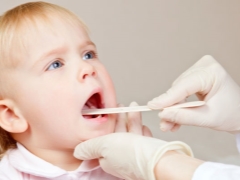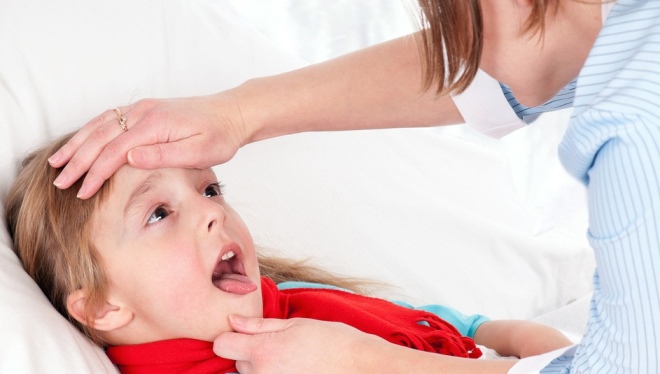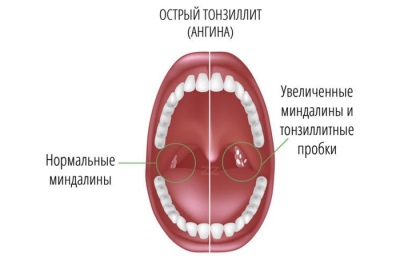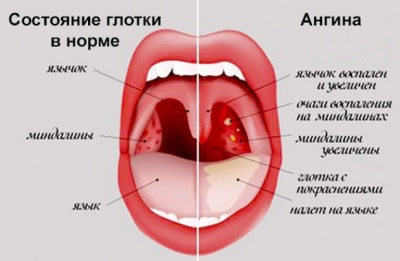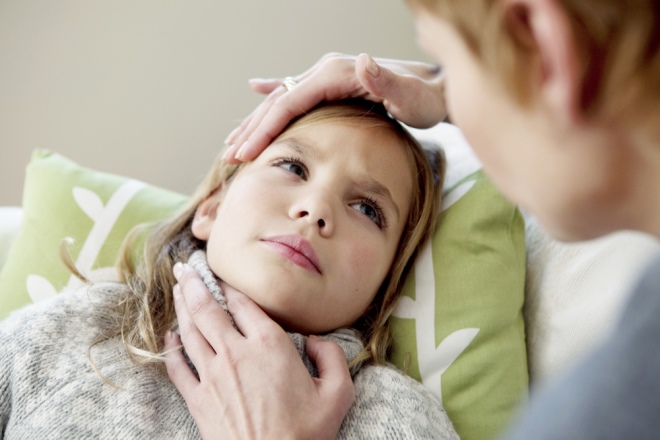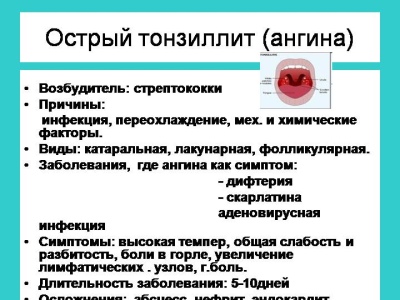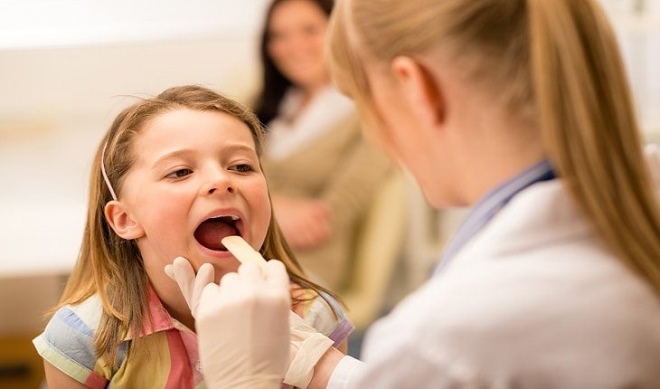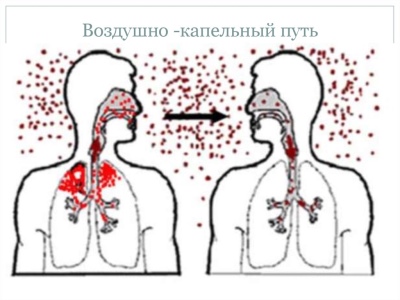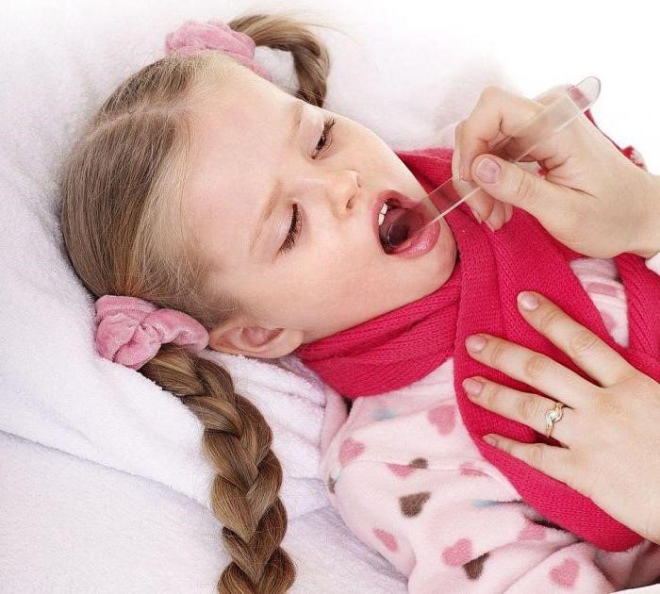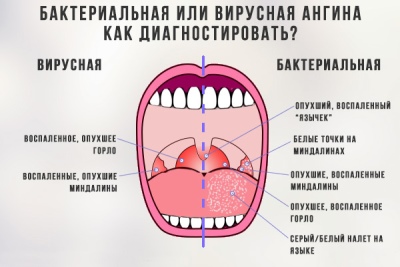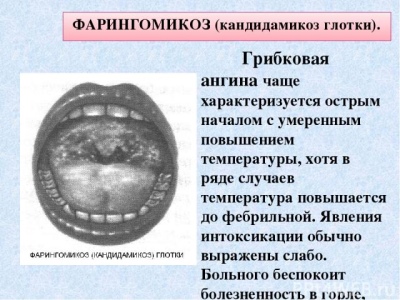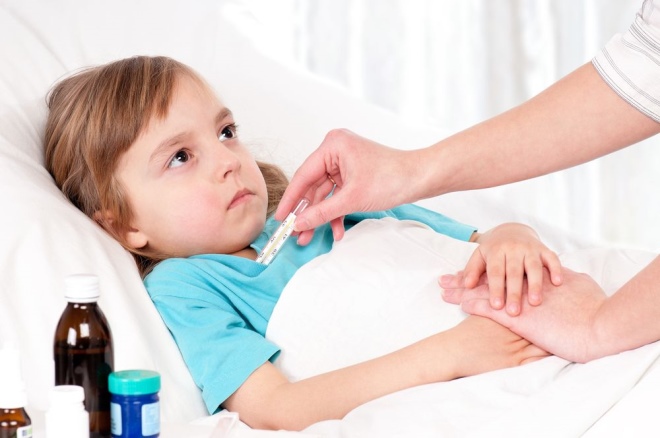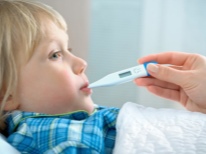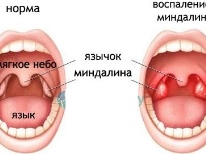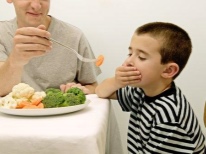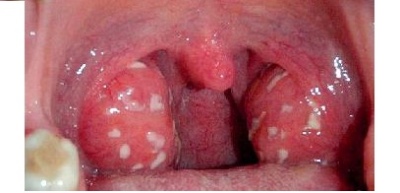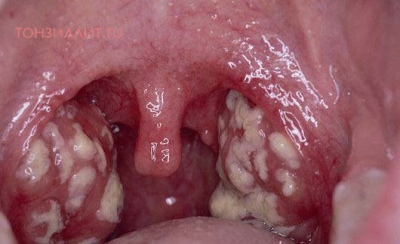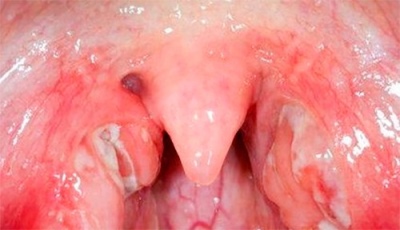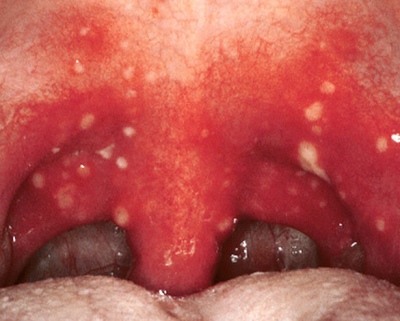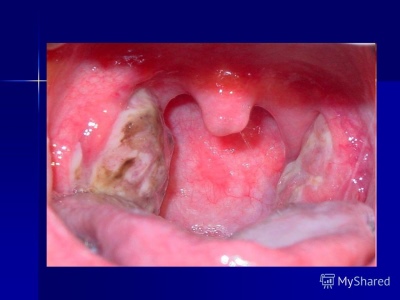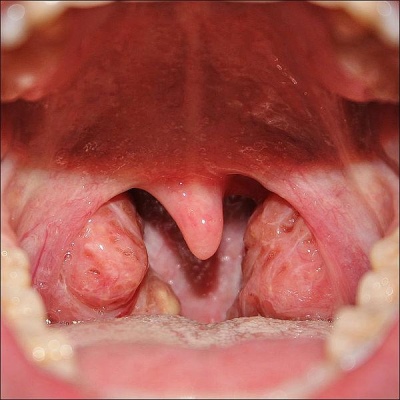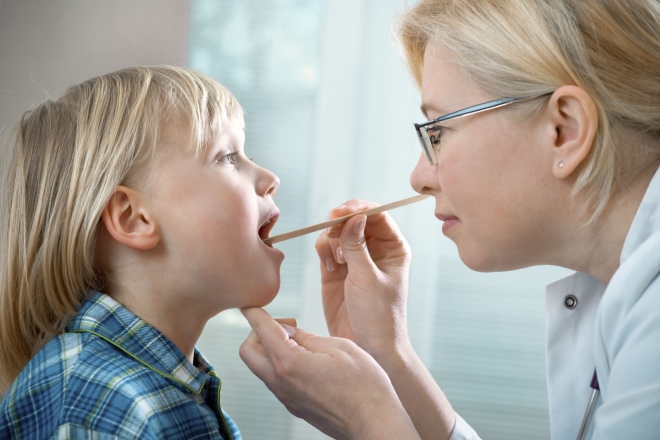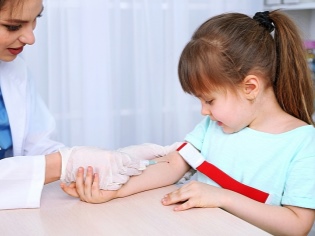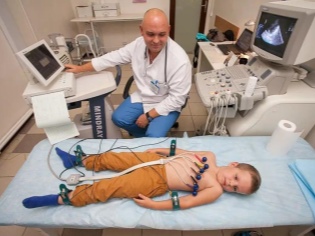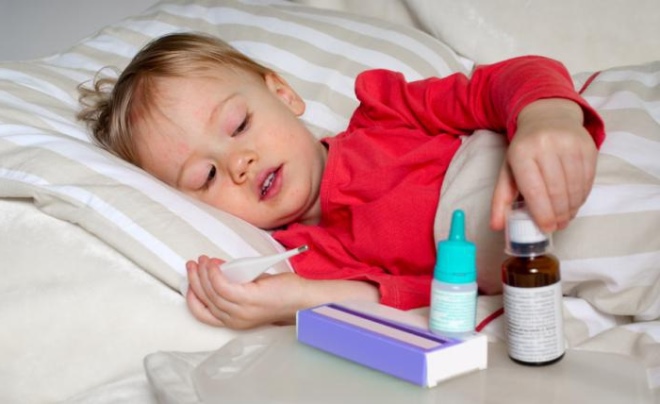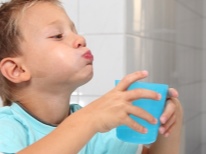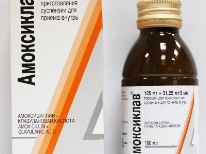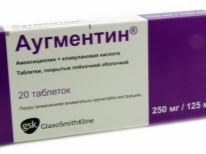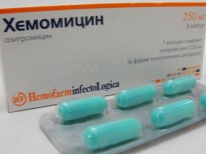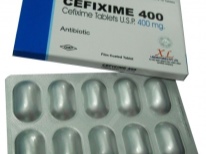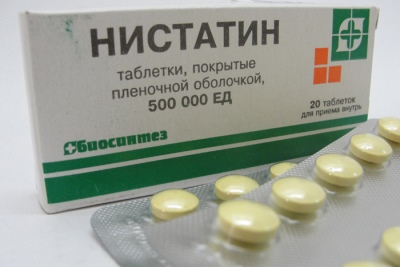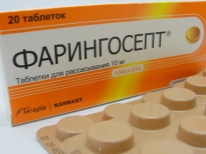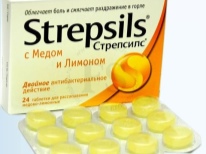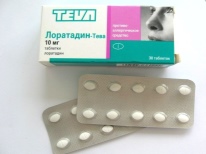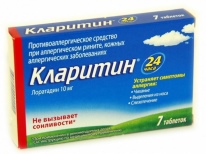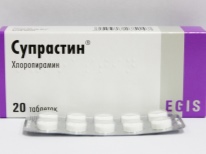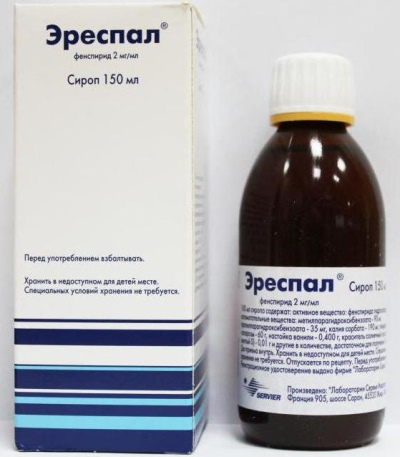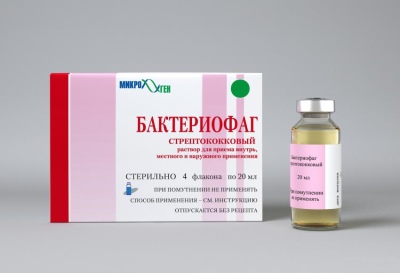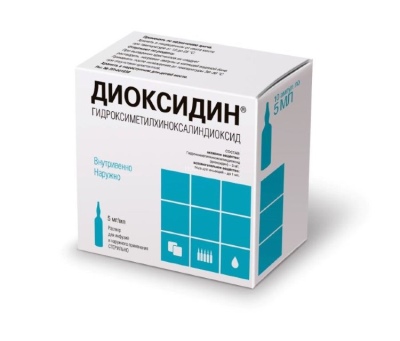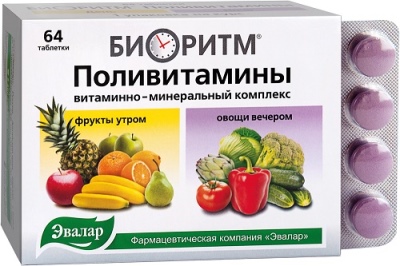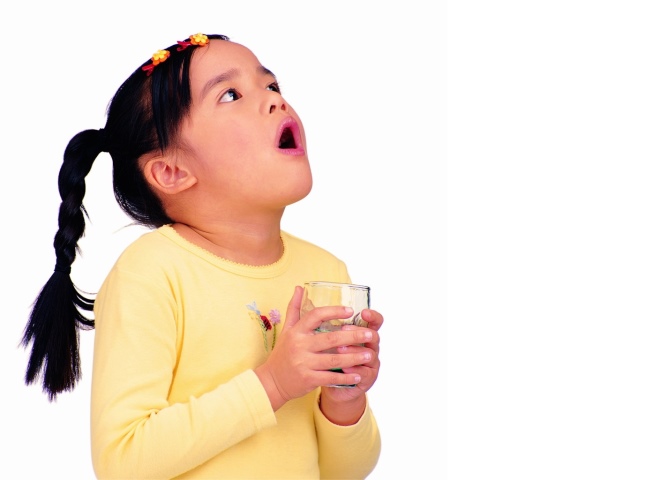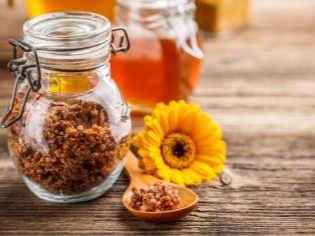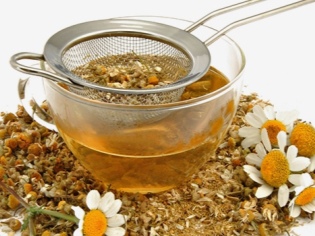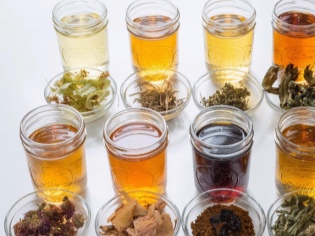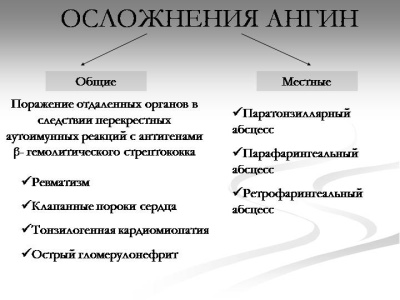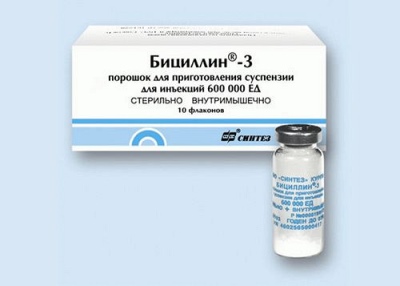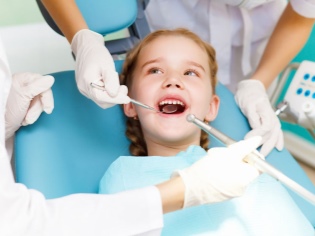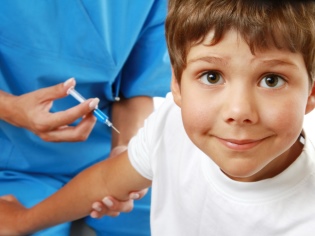Angina in a child
There are many diseases associated with severe pain in the throat when swallowing and high temperature. Most often these symptoms occur in acute tonsillitis. Not all parents know how to cope with a child's sore throat.
What it is?
Inflammation of the lymphoid tissue of the tonsils is called angina. Normally, there are several fairly large lymphatic reservoirs or tonsils in the oropharynx. These structures are composed of lymphoid tissue. The function of the tonsils is to prevent various infections from getting inside the body and localizing microbes in the upper respiratory tract. If there were no such protective barriers, then any infection could easily penetrate the body and cause severe inflammation.
The lymphoid tissue of the tonsils is represented by clusters of lymphocytes. These immune cells are able to recognize various pathogens and resist them. At the first meeting with the microbe, the lymphocytes are activated and trigger the immune response, which is aimed at the complete removal of harmful microbes from the body.
Getting on the tonsils, various microorganisms can cause an inflammatory process, which is called acute tonsillitis. About every tenth child out of a hundred has a sore throat at least once in their life. The final formation of the tonsils occurs by the age of 1.5-2 years. In the first two years of life babies and babies do not practically suffer from acute tonsillitis (due to anatomical features).
Causes
Various factors can lead to the development of angina in a child. All angina is divided into primary and secondary. If the disease is independent, and some pathogen caused its appearance, then in this case it is called primary. If your child has chronic diseases of the upper respiratory tract, diabetes and other endocrinological pathologies, cancer tumors, which are accompanied by a sharp decrease in immunity, symptoms of angina can also appear. Such forms are called secondary.
The appearance of a sore throat most often leads to:
- Bacteria. In 80% of cases, b-hemolytic streptococcus contributes to the development of the disease. It causes the greatest number of occurrences of angina, and also provokes the development of complications. In 15% of cases, staphylococcus becomes the culprit for angina. The remaining share is due to hemophilic bacilli, streptococci and anaerobic bacteria.
- Viruses. Herpes, adenoviruses, parainfluenza and influenza viruses are the most common causative agents. viral sore throats of nature. They cause disease much less frequently than bacteria. Such forms of the disease are worse detected. They are characterized by the rapid addition of secondary bacterial flora to the inflammatory process on the tonsils.
- Mushrooms Most often found in debilitated children, babies after irradiation or chemotherapy due to oncology, as well as in those with tuberculosis. Candida acts as the causative agent of the fungal form of sore throat.These fungi can cause severe damage to the tonsils with the development of acute tonsillitis.
- The simplest. There are rarely enough. Characterized by high fever and the development of severe inflammation on the tonsils. They are registered in epidemiologically unfavorable conditions and regions of residence, as well as in violation of the rules of personal hygiene. May occur in case of damage to water supply and use of poor-quality water contaminated with protozoa.
Even when a microbe enters the body, inflammation does not always develop and symptoms of acute tonsillitis appear.. The development of the disease depends on several conditions:
- The level of local immunity. Weakened and often ill children (as well as those suffering from serious serious diseases of internal organs) are infected more often. All chronic diseases, accompanied by frequent exacerbations, lead to a strong decrease in immunity. This makes the “gateway” for the infection - the tonsils - vulnerable.
- Contact with a sick person, in whose body there is a pathogen. Outbreaks of sore throats are most common in groups. This is due to the increased risk that occurs as a result of a long stay in the same conditions. Even carrying out regular disinfection of premises can not always help in preventing infection due to the high resistance of microorganisms to disinfectants.
- Poor nutrition and severe exhaustion. Excessive prolonged physical and psycho-emotional stress leads to a decrease in the level of immunity, which affects the work of the tonsils. Children who receive insufficiently needed nutrients and vitamins from food are more susceptible to infection by various types of infections leading to the development of angina.
- The presence of chronic diseases of the tonsils and other ENT organs. Otitis, sinusitis and sinusitis can lead to persistent chronic inflammation. This contributes to a change in the structure of the tonsils. They become more friable, which leads to easy penetration of any dangerous microorganisms. Even untreated carious teeth can be the culprit for the development of acute inflammation on the tonsils.
How is it transmitted?
Kids get angina mainly by airborne droplets. Anyone who has an infectious agent in their blood is contagious. The danger of infection will disappear only after adequate antibiotic therapy.
Viruses and bacteria, as a rule, are well preserved in the environment. They are resistant to low temperatures and disinfectant treatment. In contact with the mucous membranes of the upper respiratory tract, they begin to multiply rapidly, which leads to a significant increase in the number of dangerous microorganisms. After a few hours, colonies of viruses or bacteria begin to attack the tonsils, intensifying the inflammatory process.
The most common cases of angina are children between the ages of 3 and 7 years. Schoolchildren and teenagers can also get sick, but this is much less common. Also characterized by massive outbreaks of the disease. Most often, such cases are recorded in toddlers attending kindergarten. The use of someone else's dishes, as well as close contacts of children during active games often lead to rapid infection with angina.
Also recorded intra-family cases of the disease. As a rule, use of common utensils or insufficiently good processing of cutlery after meals leads to them. In this case, the infection occurs through the remnants of saliva, which is well preserves in itself various microbes for a long time. If there are several babies at home, playing with the same toys can also lead to infection.
Incubation period
Manifestations of angina do not occur immediately after the microbes enter the children's body. Some time must elapse before the first symptoms appear.It is called the incubation period. This time may be different and depends on the pathogen, which was responsible for the occurrence of angina.
PIn bacterial forms of the disease, the incubation period lasts 7-14 days. For the development of viral variants of angina requires up to a week. Symptoms in fungal forms of the disease appear only after 14-21 days. Severe hypothermia can reduce the incubation period. The weaker the immune system, the sooner the first signs of the disease appear.
Kinds
Given the various reasons that can cause disease, all angina can be divided into several types:
- Infectious. May be bacterial or viral. It occurs most often. Most often caused by streptococcal and staphylococcal flora. To eliminate the symptoms of the disease requires the appointment of antibiotics and antiviral drugs.
- Fungal. It is much less common. Most often recorded in impaired babies. Usually caused by candidal fungi. For recovery requires the normalization of immunity. Treatment is usually long. In some cases, the transition of the acute to the chronic process occurs.
By severity, all sore throats are divided into:
- Lungs. Proceed mainly in the lacunar form. Characterized by a rise in temperature to subfebrile indicators. On the surface of the tonsils almost no purulent deposits. Well treatable.
- Medium heavy. Characterized by increasing the temperature to 38-38.5 degrees. Cause a pronounced deterioration of health. On the tonsils appear purulent attacks. Can be treated at home, but under the strict supervision and supervision of the attending physician.
- Heavy. Body temperature rises above 39 degrees. Consciousness may appear. Bring pronounced suffering to the baby. The treatment is carried out in a hospital, with the development of complications - in the intensive care unit. Such diseases are dangerous, because after they may appear complications.
Symptoms
To recognize a sore throat is quite simple. This disease is characterized by special first signs that bring the baby strong discomfort and disrupt his general condition. The illness begins acutely. After the end of the incubation period, during which there are no specific symptoms, there are adverse manifestations of angina.
These include:
- The rapid jump in body temperature. During the first day it rises to 38-39 and remains high for 2-3 days. Against the background of this increase, fever or severe chills often appear. The baby feels fever, sweating increases. In some cases, weakened babies can have a sore throat without fever. Most often this condition is characteristic of fungal infections.
- Pain when swallowing. Even rubbed food on the first day can cause severe pain. Then, when using special medications, this symptom disappears.
- Red throat. The oropharynx becomes bright scarlet. In viral infections, a small grain of the pharynx is visible.
- Enlarged tonsils. They increase in size, begin to hang over the entrance to the mouth. In some forms of the disease, purulent deposits appear on the tonsils, which look like thick yellowish crusts. When attempting to touch the tonsils with a spoon or spatula, slight bleeding may begin.
- Headache and general weakness. Against the background of a pronounced increase in temperature, symptoms of intoxication are growing significantly. Headache becomes arching, spreads over the entire head. The higher the body temperature, the greater the intensity of the pain syndrome. Antipyretic drugs bring temporary relief.
- Increased peripheral lymph nodes. Most often with angina, submandibular and parotid lymph nodes are enlarged.When feeling, they are defined as dense, elastic, rounded formations connected to the skin. During the acute process they usually hurt.
- Behavior change. Against the background of severe intoxication, the kids become more capricious, refuse to eat. Their appetite worsens, sleep is disturbed. During the day, the baby appears excessive sleepiness. Younger children are more asking for their hands and may cry.
What does it look like?
There are several forms of angina, depending on the degree of damage to the lymphoid tissue of the tonsils. They also differ in appearance and features of the inflammatory process on the tonsils.
There are several forms of the disease.
Catarrhal
Characterized by the appearance of pain when swallowing while eating food.
In some cases, accompanied only by the appearance of redness in the throat and the development of excessive dryness in the oral cavity. Tonsils are enlarged in size, with a grayish tinge. Zev - red, inflamed.
Follicular
It is characterized by the rapid development of symptoms and a short incubation period. Body temperature rises to 39-39.5 degrees.
On the surface of the tonsils formed numerous ulcers and raids. A few days later, strong erosion and ulcers appear in their place.
Lacunar
It is characterized by the appearance of a strong purulent deposit on the surface of the tonsils. After 4-6 days, purulent plugs move away from the surface with the formation of numerous ulcers.
In this form of the disease, the submandibular and occipital lymph nodes are significantly increased in size.
Fibrinous
It resembles the development of the lacunary form. The tonsil raids are grayish and membranous. Often, they also resemble similar rashes, as in diphtheria.
In order to correctly establish the diagnosis and rule out a similar disease, a smear is taken from the surface of the inflamed tonsils for laboratory analysis.
Phlegmonous
The most severe variant of the disease. It is characterized by filling the entire tissue of the tonsils with pus from the inside.
It is difficult, with high body temperature and severe pain in the oropharynx when swallowing. May cause the development of life-threatening complications, which may even require surgical intervention.
Herpes
Characterized by the increase in hyperthermia to 40 degrees. It occurs as a result of herpes infection.
The tonsils outside are covered with numerous bubbles filled with muddy and gray-bloody contents. Accompanied by severe pain in the peripheral lymph nodes.
Gangrenous
This is Simanovsky-Vincent's disease. Characterized by the appearance of strong necrosis on the surface of the tonsils. They become enlarged, with the presence of large grayish-green ulcers with copiously leaking contents that have an unpleasant odor.
The disease is treatable; complete recovery is possible.
Fungal
Characterized by the appearance of whitish or gray plaque on the tonsils, similar to cottage cheese. Palatine arches become enlarged, bright red. Attempts to remove plaque may increase bleeding.
The disease occurs with an increase in body temperature to febrile indices.
Mixed
Characterized by the development of several of the above options. Occurs when infected with various pathogens - simultaneously or for a short period of time.
It may have various signs characteristic of different variants of the disease. Requires the appointment of complex treatment.
How to distinguish from ARVI?
Angina develops much faster than other infectious diseases. In acute respiratory viral infections, body temperature rarely rises above 38 degrees. For angina, persistent febrile is typical already on the first day of the disease.
SARS is accompanied by the appearance of numerous catarrhal symptoms.Toddlers get a bad cold and have a cough. There may be watery and red eyes. For angina, the development of catarrhal symptoms is not typical. This is only possible in cases where various viruses cause the disease.
Sore throats are also characterized by special changes in blood tests, which is practically not the case with ARVI. The course of acute tonsillitis is much harder than the common cold. Late treatment can lead to the development of dangerous complications, which greatly violate the child's usual way of life. The consequences of severe angina can even lead to the development of disability.
Diagnostics
If you suspect a sore throat should be called to the house of the attending physician. Lead the child to the children's clinic - not the best idea. As a rule, parents treat a baby to a doctor already during a pronounced increase in body temperature. Long waiting for reception in a long queue can lead to a deterioration of the baby’s well-being (and even to aggravation of the disease).
On examination, the doctor will pay particular attention to the appearance of the pharynx and tonsils. In the presence of inflamed areas with various raids, he will be able to take material for laboratory research. Such strokes are necessarily taken from all babies with suspected tonsillitis. They allow you to accurately determine the causative agent of the disease, to find out whether it is diphtheria.
Complete blood count can establish the estimated cause of the disease. An increase in the number of leukocytes with accelerated ESR is the main symptom of infection. Bacterial processes are accompanied by an increase in stab neutrophils. A monocytic reaction, in which the level of monocytes is elevated, is characteristic of viral infections. They are also characterized by high levels of lymphocytes.
In some cases, an ECG is performed. This study helps to identify early abnormal heartbeats and arrhythmias, which are often recorded as adverse effects of the disease. Biochemical analysis with the definition of creatinine allows you to establish kidney damage, occurring in angina (as a remote complication).
With the appearance of purulent plaque on the tonsils, you should definitely show your baby an ENT doctor. The doctor will carry out an expanded examination and identify all diseases that could cause an inflammatory process. It is necessary to show the child to the dentist. Determining the presence of carious teeth is an important component of diagnosis and treatment.
Proper treatment
To eliminate all symptoms of the disease and prevent possible complications, complex treatment is prescribed. Quickly cure a sore throat will not work. Disease therapy takes an average of 7-10 days. This time is enough to eliminate germs from the body and neutralize the symptoms of intoxication.
Sore throat treatment includes:
- Drug therapy. Antibacterial drugs and antiviral agents are needed to eliminate germs. To normalize body temperature, antipyretic agents are used. Antihistamines can help eliminate the symptoms of intoxication and reduce inflammatory swelling in the tonsils.
- Plentiful warm drink. It is necessary to eliminate bacterial toxins from the body and prevent the development of toxic kidney damage.
- Rinse with a variety of drugs. Help to remove plaque from inflamed tonsils and reduce redness in the throat. They are carried out several times a day (for 5-7 days). Medicines can also be used as compresses.
- Stay in bed (until the temperature drops).
- Correct day regimen with limited physical exertion.
- Immunity strengthening and recovery of the immune system.
Drug therapy
The duration of treatment of the disease depends on the cause of the sore throat. Bacterial forms with an uncomplicated course of the disease are treated in 7-10 days.If there are complications, treatment may take two to three weeks. Viral variants of angina pass in 5-7 days. For the treatment of fungal forms will require prescription of drugs for several weeks.
All drugs used to treat angina can be divided into several groups:
- Antibiotics. A preference is given to broad-spectrum means. For the treatment of streptococcal and staphylococcal forms, clavulanic acid-protected penicillins, macrolides or preparations of the cephalosporins group are suitable. "Amoxiclav"," Ampioks "," Augmentin ","Hemomycin», «Azithromycin», «Ceftriaxone», «Cefixime"Perfect for removing germs from the body." May be administered in pills or injections.
- Antiviral. Helps to eliminate viruses from the body, and also stimulates the immune system. Often, for the treatment of angina, doctors write out "Isoprinosine". The drug is prescribed to kids from three years. It is used 3-4 times a day (for 5-7 days - depending on the severity of the disease).
- Antifungal. With long-term use can cause severe nausea and abdominal pain. Helps to eliminate the symptoms of angina caused by fungi. Pills "Nystatin»It is better to hold in the mouth for several minutes after chewing. This will help enhance the local effect of the application.
- Pain relievers for the throat. Such agents have an antiseptic effect, and also eliminate severe inflammation on the tonsils. Appointed in sweet candy, which are easily absorbed and have different fruit and berry flavors. "Faringosept», «Septolete», «Strepsils»And many other medicines do an excellent job of eliminating pain when swallowing.
- Antihistamines. Copes with a strong swelling of the tonsils, as well as reduce the symptoms of intoxication. Appointed for 4-5 days. "Loratadine», «Claritin"," Suprastin "and other drugs are used for severe adverse symptoms of the disease. Used 1-2 times a day, mainly in the first half.
- Auxiliary means. «Erespal"Helps eliminate inflammation in the upper respiratory tract, relieves bronchospasm symptoms. Can be used for kids older than two years. Appointed as a syrup. The drug helps to eliminate hoarseness and normalizes breathing.
- Bacteriophages. Special medicines that allow you to effectively deal with various viruses. Can be used for toddlers. Purified polyvalent pyobacteriophage helps to treat the purulent processes on the tonsils. The drug effectively deals with staphylococci, streptococci, Proteus, and also with E. coli.
- Rinse with various antiseptics. «Dioxidine»Allows you to effectively deal with staphylococcal and streptococcal infections. Rinse done 3-4 times a day (during the week). After processing the pharynx and oral cavity can not eat (within an hour). It helps to eliminate the constant pain when swallowing, which often accompanies a sore throat.
- Antipyretic. Apply only when the body temperature rises above 38 degrees. Constant use of drugs is not required. Babies are usually prescribed paracetamol-based medications. These medicines effectively normalize body temperature and help eliminate high fever.
- Multivitamin Complexes. Enrich the body with all necessary trace elements and biologically active substances. Such complexes help to normalize the immune system and speed up recovery.
How to gargle properly?
For the preparation of gargles for the throat, you can use ready-made medicines or prepare decoctions of medicinal plants at home. It helps to alleviate the condition and reduce pain when swallowing.
To properly gargle, you should use the following tips:
- Prepare a medicinal infusion or drug solution of the drug.
- The temperature of the rinse should be comfortable. Too hot or cold drugs can cause additional trauma to the tonsils. The temperature of the therapeutic solution should be 40-45 degrees.
- Rinse can only be carried out by children older than three years. Children younger than the procedure is dangerous. It will not only not provide a pronounced effect, but may also lead to the fact that the child inadvertently chokes or chokes with a solution.
- For rinsing children, no more than 100 ml of solution is enough.
- It is better to rinse with a small amount of liquid. Small children should tilt their heads forward during the procedure. This will help prevent swallowing.
- Rinse should be carried out after 1-1.5 hours after a meal, not before.
Rinsing with soda solution, hydrogen peroxide, diluted dioxidine, as well as with sea salt will be suitable for treating angina. These tools reduce inflammation on the tonsils, and also help to eliminate the germs that caused sore throat. Inhalation during the acute period of the disease is better not to carry out, as this may lead to the development of complications. The tonsil tissue loosened due to inflammation is very sensitive to any irritation and is easily injured.
Effective herbal remedies for the treatment
For rinsing a sore throat, you can use not only finished medications. You can prepare medicines at home. Propolis is excellent for the treatment of inflamed tonsils and palatine arches. This product of beekeeping helps to cope with severe inflammation, after it there are almost no adverse reactions. Do not use propolis to babies who are allergic to honey.
Rosehip infusion contains a large amount of ascorbic acid. This home remedy helps to eliminate inflammation, and also effectively copes with the washing of the tonsils. To prepare the infusion you need to brew a glass of boiling water 2 tablespoons of rosehips. Infusion home remedy should be within an hour. Flush tonsils need 3-4 times a day.
Sea buckthorn oil is used to remove congestion from the tonsils.. It has a strong antiseptic effect and helps eliminate inflammation. This tool is also suitable for the treatment of eroded areas of the tonsils. Included in the composition of sea buckthorn oil biologically active substances have a regenerating effect. It helps to heal the sores and wounds on the tonsils.
Rinsing with chamomile helps to eliminate inflammation in the throat. This medicinal plant causes a minimum of side effects and effectively copes with the elimination of adverse symptoms of the disease.
Chamomile reduces redness in the throat, and also helps fight against pathogens that cause inflammation of the tonsils. The finished drug "Rotokan»Also effectively copes with all adverse symptoms of the disease and does not require additional preparation.
Diet
In the early days of the disease is very important to comply with the diet. All dishes must be sufficiently nutritious. Protein products that are easily absorbed by the body are perfect for quick recovery.
Be sure to include in the menu of a sick child, chicken, white fish and beef. All dishes should be steamed or baked.
In the early days of the disease, broths or pureed soups are perfect. You can add the menu and soups, mashed, cooked in chicken broth using cauliflower and potatoes. Meat products can be cooked in the form of meatballs, meatballs, and quenelles. Such a consistency of food is better absorbed and does not cause pain when swallowing.
Food temperature should be optimal. Too hot or cold foods can additionally injure damaged tonsils. The temperature of freshly prepared food should be no higher than 60 degrees. Ice cream and juice from the refrigerator should be temporarily excluded. Too spicy, canned and pickled meals at the time of the acute period of the disease are completely excluded.
Drinking regimen is also very important to eliminate the symptoms of intoxication. Every day, a sick baby should drink at least a liter of fluid per day. For this, decoctions and fruit drinks, which contain a large amount of vitamin C, are suitable. Tea with lemon, dogrose broth, and berry fruit drinks will help to compensate for the deficiency of trace elements in the body and lead to a quick recovery.
Daily regime
The first days of the disease are accompanied by high fever, which leads to severe sleepiness. Baby constantly wants to sleep. This defensive reaction allows the body to recover faster and accumulate the forces it will need for a quick recovery.
At night, the baby must sleep at least 8-9 hours. In the daytime should also be given enough time to sleep. Very good, if the daily rest is at least 3-4 hours.
At high temperatures, the baby must be in bed. Bed rest not only contributes to quick recovery, but also helps prevent all possible complications.
When can I walk?
Walking in the open air should be postponed for some time. In the first 3-4 days at high temperatures, you should not walk. Such walks can only weaken the sick body of the baby. You can resume them 5-6 days after the onset of the disease. For walks, you should choose comfortable clothes that will not lead to overheating. This will help prevent the violation of thermoregulation, which will only worsen the course of the disease.
When can I bathe?
On the first day of the disease hygienic baths are prohibited. They are especially unfavorable for high body temperature. Such baths can lead to subsequent hypothermia. Bathing should be postponed for several days. After the temperature normalizes, you can bathe the baby in the shower (without long sitting in the bathroom). In the water while swimming, you can add a decoction of chamomile or calendula. This gives water antiseptic properties. Such baths can be provided by the end of the first week after the onset of the disease. They will help your baby recover faster.
Complications and consequences
Angina can be very dangerous. In this disease develop both fast and long-term complications. With angina, snoring is quite common. Inflamed palatine tonsils, enlarged in size, lead to respiratory failure.
In the first month after a sore throat, the following complications can develop:
- Purulent phlegmon or abscess.
- Acute otitis or sinusitis.
- Lymphadenitis. The inflammatory process can also go to the mediastinal organs.
- The spread of infection throughout the body (with the development of sepsis).
Even after treatment, complications can develop after several months or years. This most often occurs as a result of a treatment that is not sufficiently effective. Among the remote consequences of the most common:
- Rheumatic arthritis with the defeat of large joints.
- Damage to the central nervous system as a result of rheumatism is a minor chorea.
- Defects of heart valves with the development of stenosis and insufficiency. The mitral and aortic valves are most often affected. Such acquired defects are found, as a rule, already in adulthood.
- Inflammation of the heart muscle. Symptoms of heart failure may occur. Determined only by ECG and cardiac echocardiography. Symptoms may develop several months (or even years) after a sore throat.
- Toxic damage to blood capillary walls. Such inflammation can lead to the development of hemorrhagic vasculitis. · The appearance of autoimmune diseases. Thrombocytopenic purpura may appear after previous angina. It is accompanied by severe malfunctions of the immune system. When this violation occurs, the formation of excessive antibodies, which have a detrimental effect on their own cells and tissues.
- Infectious glomerulonephritis. Inflammation of the renal tissue due to staphylococcal and streptococcal lesions can cause damage to the renal tubules. This condition is dangerous development of renal failure.
- Acute pyelonephritis. Most often caused by staphylococci and streptococci. In this condition, the renal excretory function suffers, which leads to a violation of urine outflow.
To prevent the development of secondary complications, secondary prophylaxis is required. To do this, put an injection of penicillin prolonged action.. "Bitsillin-5" helps prevent the occurrence of infectious damage to the kidneys and secondary defects of the heart valves. This contributes to the prevention of rheumatic disease in the future. Put the drug in the clinic, on the recommendation of the attending physician.
Prevention
The following recommendations will help prevent the development of angina:
- Strengthen immunity. Proper nutrition, enriched with vitamins and microelements, and good sleep ensure good functioning of the immune system. Rest on the sea contributes to the rehabilitation of the upper respiratory tract. Such prevention helps prevent the occurrence of inflammatory diseases of the upper respiratory tract in babies.
- Regularly undergo examinations at the ENT doctor. Detection of chronic diseases and timely treatment of exacerbations will help prevent the transition of inflammation to the tonsils.
- Treatment of adenoids. Excessive development of lymphoid tissue leads to disruption of the tonsils. Adenoids not only violate breathing, but also contribute to the spread of the infectious process in all lymphatic collectors.
- Hardening. Allow to improve the immune system and lead to increased immunity. Regular hardening prevents colds and improves health.
- Reception of multivitamin complexes during seasonal colds. Useful trace elements help immune cells resist any germs.
- Regular visits to a pediatric dentist. The absence of carious teeth is the prevention of the onset of angina.
- Preventive rinsing decoction of chamomile or calendula. To prevent the occurrence of angina, such procedures should be carried out 2-3 times a year. This is definitely worth doing in the cold season: autumn and spring. Such prevention not only helps prevent the development of angina, but also protects against other respiratory diseases.
- Vaccination. The child should be vaccinated against all infections (taking into account his age). This will prevent the development of secondary angina, which are found in various childhood infections. Adherence to the vaccination schedule (national vaccination schedule) will prevent the development of dangerous acute tonsillitis in a child.
For details, see below in the transfer of Dr. Komarovsky.
